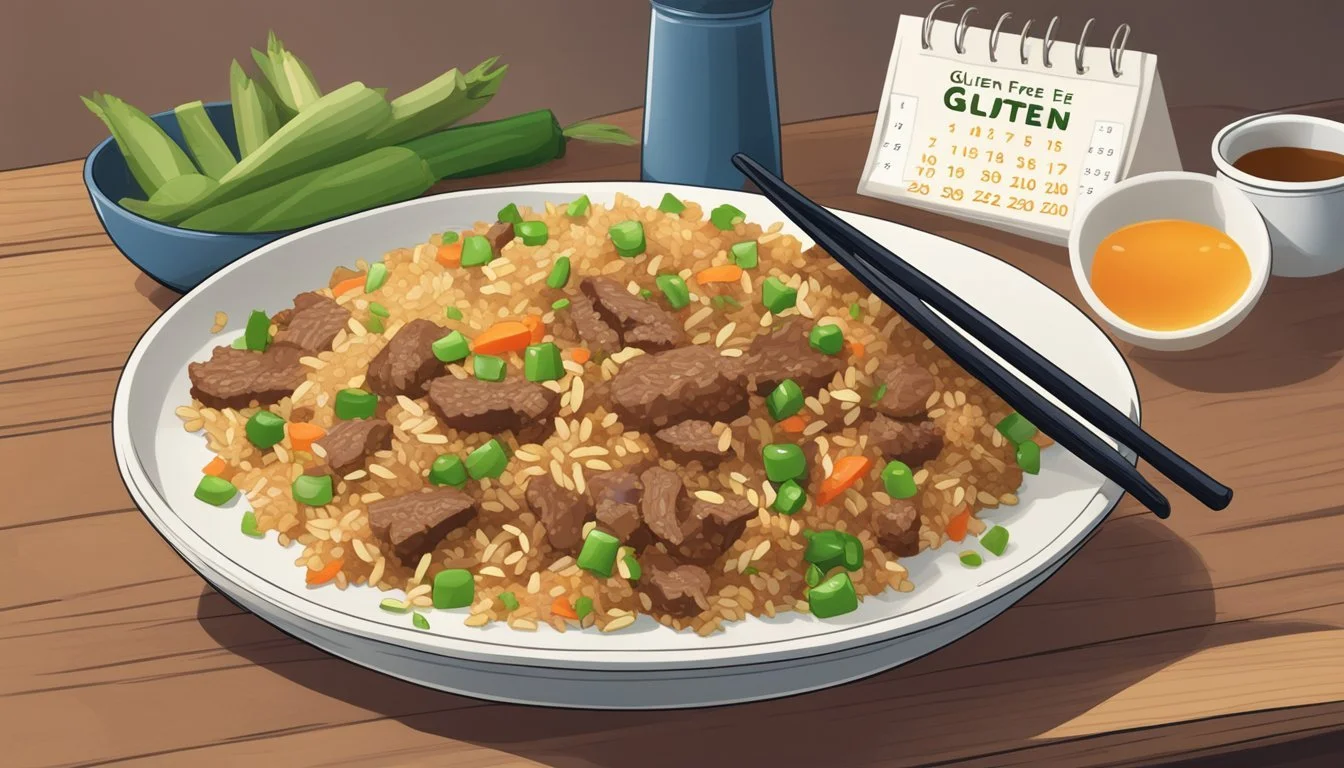How Long Does Gluten-Free Beef Fried Rice Last?
Storage Tips and Shelf Life
Properly storing gluten-free beef fried rice is essential to maintain its taste and safety. When prepared using fresh ingredients such as beef strips, cooked white rice, and gluten-free soy sauce, this delicious meal can be a great staple for several days. Gluten-free beef fried rice lasts up to four days when kept in an airtight container in the refrigerator.
To make gluten-free beef fried rice, one must pay attention to the ingredients and their freshness. Utilizing fresh beef strips, crisp vegetables, and gluten-free soy sauce ensures a flavorful dish. The inclusion of veggies like green onions and the proper seasoning with garlic and ginger enhances the dish.
Refrigerate any leftovers promptly to ensure they remain safe to eat later. Storing the fried rice in a well-sealed container prevents moisture loss and reduces the risk of contamination. This dish can be easily reheated, maintaining its deliciousness without compromising the gluten-free requirements. For best results, consume within the recommended timeframe.
Understanding Gluten-Free Beef Fried Rice
Gluten-free beef fried rice is a flavorful and nutritious dish that caters to those with gluten sensitivities. This meal typically uses gluten-free soy sauce or tamari as a key ingredient to maintain the dish's traditional taste while ensuring it's safe for those avoiding gluten.
Beef is often used in strips or cubed, and it's marinated with ingredients like coconut aminos, sesame oil, and rice vinegar to enhance flavor. This marinating process can last from 10 minutes up to overnight, depending on the desired depth of flavor.
The rice used should be pre-cooked and cooled for the best texture. Common oils for cooking this dish include olive oil, avocado oil, or vegetable oil. These oils are used to scramble eggs or sauté vegetables like carrots and onions.
Pro Tip: Cooking the rice ahead of time and letting it cool helps achieve a better texture during the frying process.
Ingredients often include:
Gluten-free soy sauce or tamari
Sesame oil
Cooking oils like olive or vegetable oil
Cooked white rice
Eggs
Vegetables like green onions, carrots, and garlic
The garlic and ginger are usually added to the heated oil before introducing the rice and other elements. This method allows the flavors to meld well. Each ingredient plays a vital role in crafting a balanced and delicious meal that adheres to gluten-free dietary needs.
Ingredient Breakdown
When preparing gluten-free beef fried rice, selecting the right ingredients is crucial for achieving a dish that is not only delicious but also meets dietary needs. Focus on quality grains, fresh vegetables, and suitable sauces to enhance both flavor and nutritional value.
Choosing the Right Rice
For gluten-free beef fried rice, choosing the right type of rice is essential. Jasmine rice and basmati rice are popular choices due to their fragrant aroma and long grains, which help in creating a fluffy texture. White rice cooks faster and has a milder flavor, making it a versatile option. For added nutrition, consider using brown rice, which offers more fiber and a slightly nutty taste. Ensure that the rice is cooked and cooled before stir-frying to prevent clumping.
Selecting Quality Beef
Selecting the right cut of beef is important for texture and taste. Beef strips for fajitas or flank steak are excellent choices due to their tenderness and thin slices, which cook quickly. Marinate the beef in a gluten-free soy sauce, such as tamari or coconut aminos, to enhance flavor. It's also vital to cook the beef over high heat for a short time to keep it juicy and tender. Ensure the beef is fully cooked but not overdone to avoid toughness.
Vegetables for Nutritional Balance
Incorporating a variety of vegetables enhances the nutritional value and flavors of the dish. Commonly used vegetables include carrots, peas, green onions, and bell peppers. Snow peas, green beans, and broccoli add a good crunch, while mushrooms provide a savory depth. It's important to chop the vegetables uniformly to ensure even cooking. Stir-fry the vegetables on medium-high heat to retain their color and crispiness.
Gluten-Free Sauce Variations
Sauces are essential for flavoring gluten-free beef fried rice. Tamari and gluten-free soy sauce are fundamental for that classic savory taste. For those looking for alternatives, coconut aminos offer a slightly sweeter and less salty option. To add a unique twist, consider using oyster sauce, which can also be found in gluten-free versions. Mixing these sauces with a bit of sesame oil will round out the flavor profile. Ensure all sauces are well-combined and added at the right time to avoid overpowering the dish.
By carefully selecting and preparing these ingredients, you can create a delicious and nutritious gluten-free beef fried rice that satisfies everyone at the table.
Proper Cooking Techniques
When preparing gluten-free beef fried rice, attention to techniques is crucial to achieve the best taste and texture. Key methods involve using the right equipment, perfecting the stir-fry process, and ensuring optimal flavor and texture.
Using the Wok or Skillet
Using a wok or skillet is essential for authentic fried rice. Woks are ideal because their shape allows even heat distribution and quick cooking.
Start by heating the wok or skillet over medium-high heat until it’s very hot. Add sesame oil or another preferred oil to the heated surface. Quickly add minced garlic and ginger, frying until aromatic. Cook the beef first to brown it thoroughly, then set it aside. The high heat ensures the meat sears properly without cooking the inside too fast.
Achieving the Perfect Stir-Fry
Stir-frying requires constant movement. Once the beef is browned and set aside, add more oil if needed and quickly introduce onions, carrots, and frozen vegetables.
Keep the ingredients moving. Use a wooden spoon or spatula to ensure even cooking. When the vegetables are tender, introduce the cooked rice, breaking up any clumps. Push ingredients to the side and scramble the eggs in the middle of the pan, then mix everything together. Add soy sauce, white pepper, and salt for seasoning.
Getting the Right Texture and Flavor
The texture and flavor of beef fried rice depend on several factors. Use cold, leftover rice for a non-sticky texture. Heat it evenly with oil in the wok or skillet.
Flavor hinges on proper seasoning. Using salt, white pepper, and soy sauce gives a balanced taste. Incorporate green onions at the end to maintain their crispness and fresh flavor. Properly cooked beef and vegetables ensure rich, robust tastes in every bite. Small amounts of marinade for the beef, including sesame oil and soy sauce, can elevate the flavor profile significantly.
Customizing Your Fried Rice
Customizing your gluten-free beef fried rice allows you to tailor flavors and ingredients to your liking, from adding different proteins to making it suitable for vegetarian and vegan diets, or even enhancing it with various garnishes.
Adding Additional Proteins
Incorporating various proteins can enhance the taste and nutritional value of your fried rice. Chicken and shrimp are popular choices, offering a light but flavorful addition. Pork, such as ham or steak tips, can provide a richer taste.
Tofu serves as an excellent option for those seeking a meat-free diet, while scrambled eggs can lend a classic touch. Ground ginger and soy sauce can help season these proteins, making them a seamless blend with the rice.
Experimenting with these additions can keep your fried rice varied and interesting.
Making Vegetarian and Vegan Variations
For a vegetarian or vegan version, the key is to focus on plant-based protein and fresh vegetables. Tofu is a versatile protein that absorbs flavors well and blends perfectly with rice.
Using vegetables like green peas, carrots, and bell peppers can add crunch and color. To boost the umami flavor without animal products, try soy sauce or coconut aminos.
Including aromatic herbs and spices like fresh cilantro and ground ginger can also elevate the overall taste, making your fried rice both flavorful and nutritious.
Personalizing with Garnishes
Garnishes can significantly enhance the presentation and taste of your fried rice. Sesame seeds can add a satisfying crunch and a subtle nutty flavor. Fresh cilantro can provide a burst of freshness and color.
Adding sliced green onions or a sprinkle of chopped peanuts can create a delightful texture contrast. For a bit of heat, consider thinly sliced chili peppers or a dash of hot sauce.
Final touches like these can transform a simple dish into a visually appealing and palate-pleasing meal.
Storing Gluten-Free Beef Fried Rice
Proper storage of gluten-free beef fried rice ensures its freshness and safety. Learn how to store it in the refrigerator and freezer, and how to reheat it without losing quality.
Refrigerator Storage Tips
Gluten-free beef fried rice can last for 3-4 days in the refrigerator. To maximize its shelf life, place the leftovers in an airtight container.
Steps:
Allow the fried rice to cool to room temperature.
Transfer the rice to a container with a secure lid.
Moisture is the enemy of leftover rice. Make sure the container is sealed tightly to prevent moisture from getting in, which can lead to a mushy texture.
Freezing for Long-Term Preservation
For long-term storage, freezing is the best option. When stored properly, gluten-free beef fried rice can last up to three months in the freezer.
Steps:
Cool the fried rice completely.
Divide the rice into portions for easier thawing later.
Place portions in airtight containers or heavy-duty freezer bags.
Label with the date of freezing.
Removing as much air as possible from freezer bags helps prevent freezer burn. When you’re ready to eat, thaw the portions in the refrigerator overnight.
Reheating Without Compromising Quality
Reheating fried rice without compromising its texture and taste is crucial. Use the following methods:
Microwave:
Place rice in a microwave-safe dish.
Add a splash of water to keep it moist.
Cover with a microwave-safe lid or plate.
Heat in 1-minute intervals, stirring in between.
Pot:
Heat a bit of oil in a pot over medium heat.
Add the rice and stir frequently.
Cook until thoroughly heated.
These methods help maintain the original texture and flavor of the gluten-free beef fried rice, ensuring a delicious experience.







